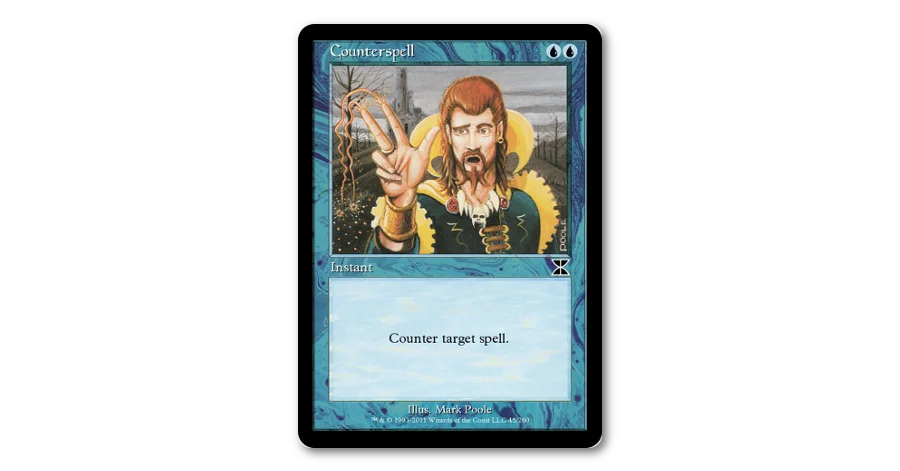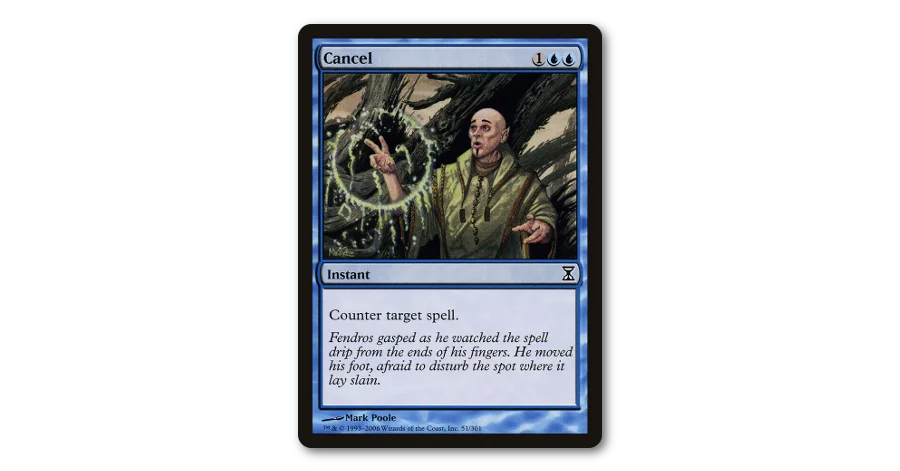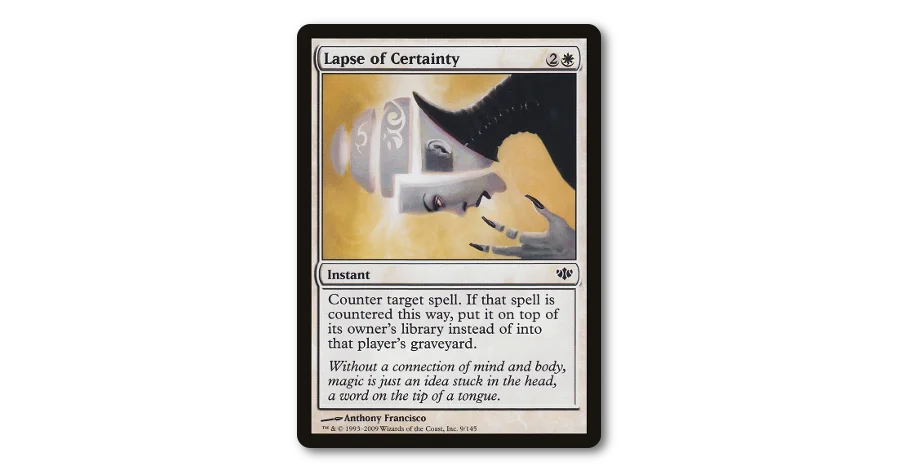Seriously. That’s it. Those four words.
Alright, fine.
White in the Throne of Eldraine standard period, isn’t great! It’s not very strong and uh, also in Commander, white’s not very strong, and so the Content Creation mill has kicked in and presented the brilliant idea of White Bad. The Magic community, being the reasonable well-rounded and thoughtful group of people they are have immediately leapt face-first into a wall.
We’re not good with handling conversations that need words.
One of the places that people have decided this needs addressing is by saying that white (which is the WORST COLOUR and ALWAYS SUCKS) needs to have CARD DRAW and RAMP and COUNTERSPELLS. Now, I’ve some sympathy to the problems presented before (and I’ve written about it), but the last one bothers me, because it’s the same, simple, looping argument. It’s very catastrophised and gets to involve things like ‘Maro doesn’t know what he’s talking about’ and ‘Maro hates white,’ which… yeah. Do I bust out the statistics and the historical context to address these arguments? Sometimes – it’s just it’s work, and because it’s social media, that argument drifts away and I have to go re-make it an hour later. I want it all centralised and convenient.
Here, then is my thoughts on why we should stop designing custom white counterspells. If you’re a Wizards employee, current or former, rejoice, because I’m not going to show any custom designs here or even talk about them in depth. I’m just going to go over the idea of white getting counterspells at all.
And first, some context!
Defining A Counterspell

First of all in this discussion, a counterspell refers to a card, usually an instant, that can be cast targeting one or more or all of an opponent’s spells, to prevent them from resolving. The simplest version you can find is literally just Counterspell.
This effect has been around since Alpha, and since that time it’s been explored a lot. It’s been tried on red cards and green cards and black cards and it’s been tried on white cards and it’s gone through a bunch of major shakeups. It was pretty oppressive for the first ten years of the game, honestly, and attempts were made to address this effect’s impact on the game starting around the release of Onslaught in 2002.
There are some permutations that get a little weird – Remand, for example, which kicks the spell back into the owner’s hand, and Delay, and Memory Lapse, which stop the card (and the mana your opponent invested in it and the opportunity for that card to have the impact they wanted) but don’t necessarily get rid of it. These cards exist in a little side space, particularly because the impact they have is delaying a card. More on that later, but if you want the short on this, I think these are fine in white, they’re just not precedents for stuff like Mana Leak.
Counterspells are something I found deeply frustrating when I started playing. The idea that I struggled with was the way that a blue deck could just counter everything I tried to do, and the quality of whatever it was I wanted to try, it could just be dealt with by an opponent who only ever got stronger and stronger. Then I learned techniques for besting it, started using it, and I went through a story many players and veterans describe; I learned the problem, I learned how to beat it, and I realised it wasn’t so bad.

Except then I kept learning, and realised that actually, no it absolutely was so bad, and even though it was beatable, it was a big problem. And the environment changed and Wizards addressed a bunch of problems and that’s how we got most of what we’ve got going on now with modern Magic and the typical oblative, always-get-things counterspell being 1UU instead of UU, and a whole segment of the population are super annoying about that.
Now, the thing that I often get accused of when I criticise Counterspell design of this era is that I ‘don’t like counterspells.’ This is silly, because counterspells are great. They’re fantastic tools to have in a game, because they create an opportunity for interaction, the lifeblood of this interesting and engaging game. The problem of counterspells is not counterspells being unfair or unfun, but rather that when counterspells exist, players aren’t just advancing the plan that comes off the top of their deck. They’re playing cards and having to pay attention to what their opponent could be doing, what opportunities they’re presented with, and they want to pay attention to you and see what they can do.
See, when counterspells are too easy and common, the problem becomes ‘what sneaks through the countermagic wall.’ When counterspells are fewer in number and harder to use, it becomes much more about stopping crucial cards. It’s good, it’s tense, and it lives in the same space as instant-speed removal and burn. In any situation, it’s tedious when an opponent simply has one thing they can do consistently, all the time – it’s another entirely when you can’t be sure.
Anyway, Counterspells are great, and I think the game is better for having them.
And now why White shouldn’t have them.
But first even more context.
The History of White Countermagic
Normally when we talk about creating cards for Magic: The Gathering, we look at the historical context. What cards like this exist, what has been done before, how does this relate to the colour pie, all that stuff.
First we can set aside all the counterspells that are blue and white, like Absorb and Overrule. They’re counterspells you can’t (usually) use without blue mana, which means that if you’re playing them you’re playing a deck that is at least partially blue. They’re fine, they’re blue bringing a blue effect to the table.
Then we need to set aside some cards that are just white cards which require you to spend blue mana to activate them – that’s stuff like Teferi's Care, Arenson's Aura, and Soulsworn Jury. These are designs that are great for multicolour sets that let you use cards that can go in one colour to fill out options for two-colour decks. Again, those cards are using blue to do blue things. Great!
And then, we set aside the cards that are on board and say ‘counter that spell.’ Why? Well, because those cards aren’t counterspells, they aren’t reactive responses that stop a spell from happening. While they are ‘spells that say counter’ they don’t behave the way that blue counterspells do; in each case, they sit on the board and tell the opponents ‘you have to accommodate this rule.’ That’s fine, that’s white. That hits Presence of the Master, Chancellor of the Annex, and enduring ‘recent example’ of a counterspell, Frontline Medic. The medic frustrates me because the card is so excellently done as a way to tax big X spells, saying ‘hey, whatever X is, it’s going to be 3 less,’ – but instead people bring it up as an example not of taxing done with awareness but of ‘a counterspell.’
We can also ditch Unyaro Griffin, from Mirage, a card published in 1996. This puts it alongside such other precedent cards as Flash, Dark Ritual, Cadaverous Bloom, Unyaro Bee Sting and Lion's Eye Diamond. Let’s just say it was another time.
We’re not done with the cuts yet, though: There’s Dawn Charm, Mana Tithe and Rebuff the Wicked, from Planar Chaos. PlanarChaos is a parallel universe set that’s explicitly not meant to be seen as a precedent for the colour pie. Mark Rosewater has said that Planar Chaos was a mistake because it taught people the wrong message about the colour pie, not showing them a contrast of how things ‘could have been’ but instead teaching them the idea that this is how they ‘should’ be and with only a tiny number of cards that ‘could’ be done now.
Planar Chaos was a mistake.
Alright, what does that leave us with?
One card.

Lapse of Certainty has the text of Memory Lapse. It was printed in 2009, which means in 11 years, that design has been iterated on never. That’s not to say it’s out of white’s part of the colour pie (and Mark Rosewater has said as much). Problem is that this isn’t the card people are trying to iterate on – they’re seeing Memory Lapse and think that this means White can have Counterspell.
This is something Maro’s talked about on the podcast, by the way; why you can’t do ‘just one thing.’ If a colour never does something, you can say that you don’t do it because the colour doesn’t do it. If players ask for just one thing that breaks the rule, the result is that the thing becomes precedent and you have to consciously avoid ever doing it again, because now you can’t say ‘you never do it.’ You have to choose to not do it.
At time of writing (before Theros: Beyond Death launches), there’s three thousand, nine hundred and change white cards, and of that, we have one instance where MTG put a ‘counterspell’ in white. This is a choice. This is something they want to be this way. There are more white cards with haste (Riftmarked Knight and Akroma Angel of Wrath).
Very simply, Maro has said ‘White is tertiary in countermagic,’ and he’s said that recently and pretty consistently. Not arguing that! The issue is that being tertiary at something means you only really get it very rarely, and only to fulfil specific needs that the colour has, and not to undermine the colour’s weaknesses. White does get ‘counter’ magic in this way – as noted, cards like the Frontline Strategist and Chancellor of the Annex, which are fine, but are also not precedent for giving white Mana Tithe.
(And hey, psst, you know how they’ve given white cards like Silence? and Nevermore? That kind of stuff, with abrupt interruptions and ‘hold up’ stuff? That’s where we should be looking to give white this sort of stack interaction, because those cards impose control without answering the cards.)
Infringing on Blue
Right now there is a real problem with white and green where a number of their effects bleed into one another because they’re the two colours that are the most likely to be on the battlefield with more than two creatures. Mass hexproof and mass pump, creation of a number of tokens, large, hard to kill threats, tapping out on your own turn, these are things that white and green both do a lot. There’s a real problem with making sure those colours can maintain their separate identities, and when this counterspell argument comes up, it sounds like people are running over to the opposite wall of the colour pie and are trying to kick it down.
See, White is a pretty reactive colour. This is part of why it has all those cards that are really good at punishing an opponent for doing something or building a deck in a particular way. If you attack me, I can punish you. If you want that back, you have to get rid of my enchantment. Wraths are really good at dealing with large clouds of creatures, and if your opponent only plays one creature at a time, wraths are still pretty good at killing them. If you built a deck with enchantments, white can respond to you putting that enchantment down with some of the most efficient enchantment removal that exists. Same with artifacts, too. It’s even been said though not delivered that white can have excellent planeswalker removal.
White also gets to set rules, rules that may not matter at all to you, but if they do matter, their rules are debilitating. Eidolon Of Rhetoric is meaningless to a midrange deck, and backbreaking to a storm deck.
As the colour with the ‘best answers’ as Maro puts it, White’s limit is its inability to conveniently access those answers. This is why it merges well with blue and green, colours that do get to draw cards, tutor for things, and recover cards in different ways. That white can’t do what its two allies do is important, because that’s how you know white isn’t blue. Which seems tautological, but it’s an important thing for the game design to reinforce. White has to time its answers carefully, to give itself as much time as possible to get more answers.
White then, is reactive. But blue is more reactive. How do you illustrate that? Well, the main option you have is that blue’s methods of dealing with things have to be even more narrowly timed than the white methods, and white is already doing as much as it can to leave things as late as it can. The key then, is to force blue to leave things even later, to give blue even tinier windows of opportunity to answer things perfectly.
White can deal with things, white can react to the things your opponents do. Blue has to react to the things your opponents do, with absolutely perfectly chosen timing. And that’s where the counterspell lives. Blue has to make the most of its time. It can’t just tap out endlessly and assume its great spells will carry the day – all its ability to respond to things tends to pivot around that moment of will-it-resolve-or-won’t-it.
This gets to be unique to blue, and white’s ability to mop up the spilled milk is part of what makes it, flavour-wise, be the colour that can handle setbacks and missed opportunities better. If you make white a counterspell colour too, then you’re bleeding away that distinction, and pushing white to play just like blue plays.
It’ll Never Be Enough
The fact is, the place that white is the weakest right now is in Commander, the big popular format that’s singleton. In this space, white is often described as very weak and one reason why is because on its own, it lacks the ability to stop your opponent doing things that let them win on the spot, and countermagic is seen as a way to address this. Setting aside that there are ways to do this that don’t involve giving white these oblative, reactive answers (and that it has a lot of them already), this is a problem you can’t solve in small doses with a whole mechanic like Counterspells.
Counterspells require a certain density to matter. You need to be able to present a decently large number of cards to get an effect powerful enough to work. White has taxing and other punishment effects but they’re often not good enough to put in the commander space, because you only have one or two of the best of each effect, and that means you’re completely lacking on the redundancy that these effects need to work.
Look, if you wanted to make your deck use Wrath of Gods in white, you could stack the best wraths and have something like twelve in your 100-card singleton deck. If you extended to weirder wrath variants you get even more. Redundancy of an effect is what lets a colour carry itself in commander. A few counterspells in white aren’t going to fix white in that format. If you want to fix white by giving it counterspells in that format, you need to make a lot of counterspells, and that means you’re committing more and more space every set to biting into blue’s space (as above), and all in the name of trying to catch up to twenty five years of the best colour at counterspells, while making blue more counterspells.
You can’t catch up. You can’t break even.
If ‘only one or two’ counterspells were enough, Lapse of Certainty would be enough, but it’s not. When it comes to countermagic, quantity is a quality all of its own.
TL;DR
Fixing white by giving it counterspells
- won’t work
- can’t be done in a scale that can help
- diminishes white
- diminishes blue
- and makes white a worse-defined colour
White needs help, I want to give it help, and I want to do that by making white cards and exploring the exciting space of expressing what white is, not by making it Blue #2.
And that’s it. That’s what I think.
That’s all it is.
This is my opinion. Now, I think it’s a pretty good opinion, as indicated by my spending at least two thousand words on it and counting. But at least now I can link here rather than have the same argument over and over again when I have to first lay out that Planar Chaos is not precedent.